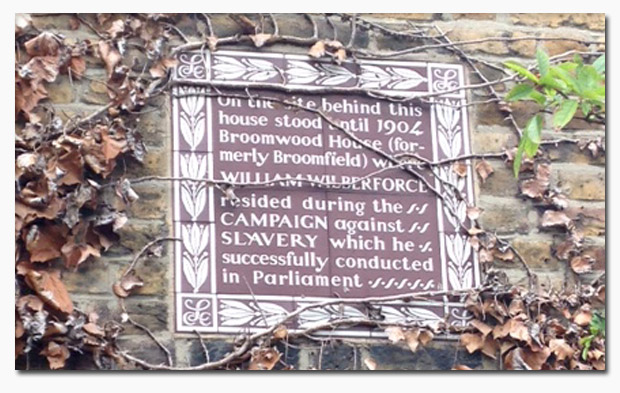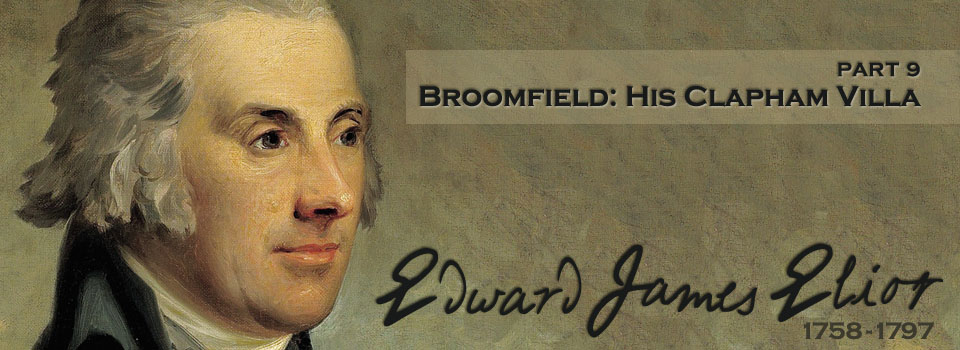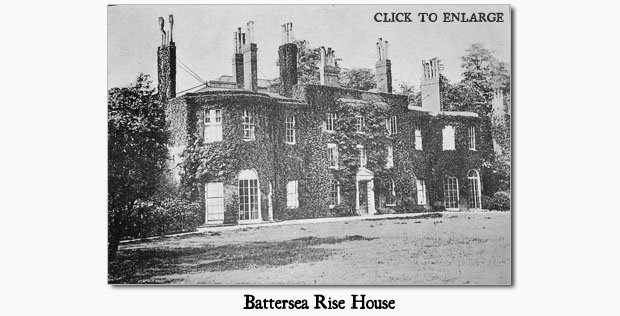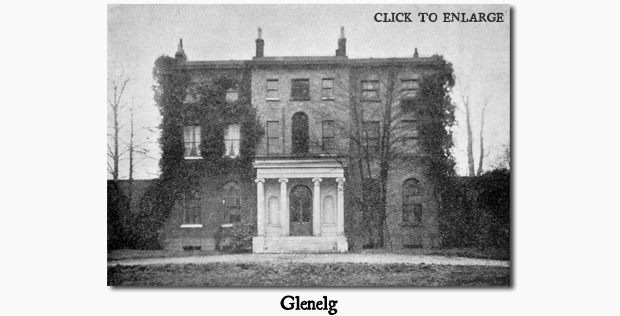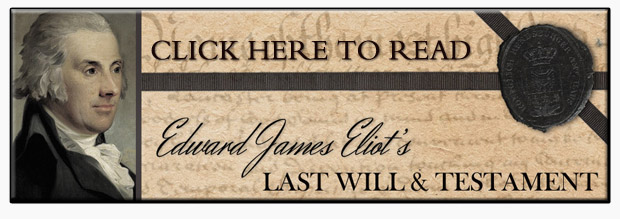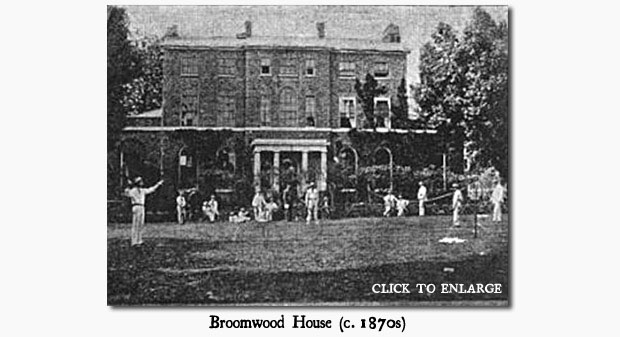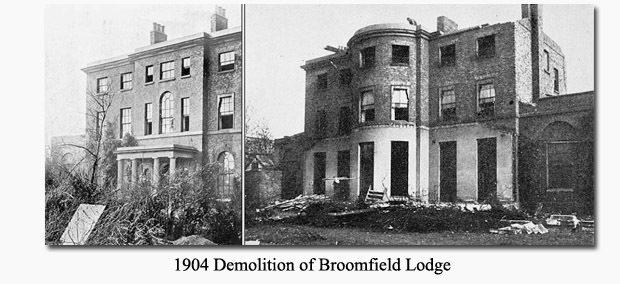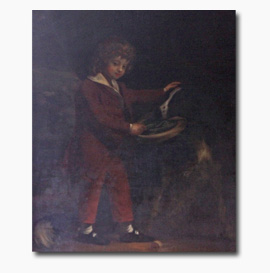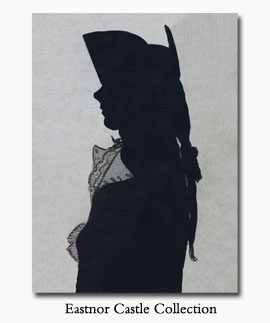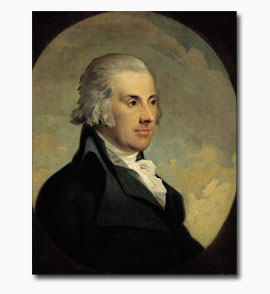Edward James Eliot: Broomfield – His Clapham Villa
His varied political and philanthropic activities drew Edward James into the circle of Wilberforce's many like-minded friends — the group who would later be referred to as "The Clapham Sect". Even though the majority of this group never actually lived in Clapham, Henry Thornton did much to draw a circle of Wilberforce's Christian friends to the area, beginning with his own purchase of Battersea Rise. For five years, he shared this house with Wilberforce as "a chummery" (being bachelors and able to share the expenses of the housekeeping). The two men were cousins and as close as brothers, sharing so completely their religious views, political views and various causes. Thornton hoped that some good would come out of their "Clapham system", saying, "Wilberforce is a candle that should not be hid under a bushel. The influence of his conversation is, I think, great and striking. I am surprised to find how much religion everybody seems to have when they get into our house. They seem all to submit, and to acknowledge the advantage of a religious life, and we are not at all queer or guilty of carrying things too far."
Without a doubt, this candle attracted many great personalities, our hero being one of the first.
It took a little time for Edward James to decide on Clapham as the place of his personal residence. He continued attached to Pitt all of his life, and he had stayed on at Downing Street for five years after Harriot's death — also spending time with his daughter and the Dowager Lady Chatham at Burton Pynsent, of course. As his grief became more controlled, and he worked more and more on matters for reform, Edward James began to want a home of his own in Clapham. This would allow for closer and more detailed work, since Wilberforce would be so near and Pitt often wanted to steal moments of peace in the country. It also gave Edward James the opportunity of bringing his little daughter to live in his own house, instead of being always with her grandmother.
The first notice that appears of Edward James' search for a house comes from the files of Sir John Soane, the noted architect. Soane did much work for the Eliot family (most importantly his early 19th-century renovations of Port Eliot), including quite a lot of help in the family's search for town houses. In March of 1791, he surveyed Captain Lewis' house at Clapham Common for his client. Obviously, this house did not suit, because five months later Soane was placing an ad for a Clapham Villa. Edward James also paid for a clerk's time and expenses in travelling to "Sydenham, Chislehurst and Roehampton to look at houses", as well as the making of plans for three houses. No records of those three house plans appear to survive in Soane's files, but Edward James did write to Mrs. Pretyman by September stating, ". . . the plan of my Clapham house has been changed two or three times since my last letter to you, which I have not at present time to explain farther than to say that it seems to be now pretty well settled, and with rooms (I think I may say considerable) larger than the original design." This is a little hard to fit into a definite order, since Edward James also wrote to Mrs. Pretyman in November, saying that his sister-in-law had been "making inquiries about a house for me in the neighbourhood of Hampstead or Highgate and says she has heard of one that she thinks will do." Perhaps his sister-in-law was hoping that he would settle nearer the family, but this is the only mention of any consideration outside of Clapham.
Whether by special request or private design, Henry Thornton presented the solution to the house-hunting problem. Having purchased a house and land for himself on the West side of Clapham Common (and having convinced Wilberforce to share it with him), he set about his vision of bringing their other friends to the area. To do this, he built two very similar houses, one on each side of his Battersea Rise estate. These were destined for the two closest friends of the Chummery Bachelors. The first was called "Glenelg" and stood next to Battersea Rise House. It was purchased by Thornton's friend, Charles Grant, a director of the East India Company and a strong Evangelicalist with great motivation. The second house was rented to Wilberforce's dear friend (and our hero), Edward James. This house was called "Broomfield" or "Broomfield Lodge", being at slightly more of a distance from Battersea Rise (on the southern end of the estate property), though the gardens were separated by only a few shrubs. By this arrangement, the men were able to meet as often and privately as they wished. (From the references in the above letters, Thornton must have built the house to Eliot's specifications and then rented it to him.)
Broomfield was described as a "small" brick mansion house, built in a rather classic style with a front measuring approximately eighty feet in length. Its situation on the western-side of the Common gave it a lovely view "commanding the beautiful prospects of the Sydenham and Surry-hills", with the ground forming "a pleasing valley towards Wandsworth Common". The public approach to the house came from the West Side of the Common by means of an avenue and carriage drive. (Broomwood Road now follows practically the same approach of the original drive.) Architectural plans dating to 1797 still survive for the ground and principal stories, showing ample rooms for servants and the housekeeping necessities — including areas marked for the Wine Cellar, the Larder, the Scullery, the Pastry, the Dairy, Small Beer, "Shoes, &c", Ashes and Coals. The principle story included a Drawing Room (with bow window), Dining Room, Library or "Common Parlour", Vestibule and a Powdering Room.
Details of Edward James' life at this new home are rather few. Not very many letters survive which were written from there, but the subject does turn up in Wilberforce's diary a number of times. Edward James was now able to bring his little girl to their new home, though a good deal of her time was still spent at Burton Pynsent, with visits to Holwood (Pitt's house) and Port Eliot. Broomfield gave our busy hero ample time for political and spiritual discussion, as well as the opportunity of attending the well-known services of Rev. John Venn at Holy Trinity Church. Pitt came to visit often, and Edward James used every opportunity he could to sustain the friendship of the Premier and the Philanthropist — even if he could not mend the chasm that had formed in the relationship of his two friends.
By 1797, just five years after his taking of Broomfield, his health began to fail at a more rapid rate, and Edward James was not able to spend very much (if any) time in Clapham. When Wilberforce married in May of that year, he and his bride rented Broomfield from Eliot in early June for the rest of the parliamentary term. Edward James never returned to Clapham. During the summer, he was in Bath for his health, only leaving in September to take Harriet Hester on a visit to his parents in Cornwall. Sadly, he never left Port Eliot, where he passed away on the 17th of September, surrounded by those he loved.
It is here that details about Broomfield become even hazier. Without a doubt, Edward James rented the house from Thornton, since he referred to him as "my landlord". However, many books state that, after Edward James' death, Wilberforce purchased Broomfield from his friend's solicitors. The question arises as to whether that is just a faulty statement or Edward James was in a sort of "rent-to-own" agreement with Thornton. No mention of the house or property appears in Eliot's will, but he does not name very many particulars, since his real concern is the guardianship of his daughter, with instructions that all "property" be sold and invested in funds for her use.
Broomfield House, a place of such history and pride, is no more. And before moving on with the story of Edward James Eliot of Port Eliot, it's interesting to document the final years of this edifice, behind whose walls two such great heroes worked and lived.
One year after her father's death, twelve-year-old Harriet Hester received a kind letter from Mr. Wilberforce. He had invited her to visit him at Broomfield, though circumstances had not permitted it — of which he was glad, because he worried that being in her old house might have affected her too much. (Obviously, she and her father had been very happy there.)
After years of being a quiet and private haven to a gentle hero "who loved the shade", Broomfield became the true center of Thornton's "Clapham System", after becoming the home of the most public hero of the group. To this house has been accorded the honour of being undoubtedly called "the place where the abolition of the slave trade was brought about", as well as being the spot where the most famous anti-slavery petition was signed. That another claim to fame may not be forgotten, mention should be made of its being the foundation place of the Church Missionary Society, formed there in 1798. It was recorded that "to Clapham the throng of petitioners flocked. His rooms were filled by crowds, which beset his table and overflowed into his verandah and garden; they came from every quarter, of every creed and tongue." It is unlikely that any famous philanthropist or politician of the era did not, at some time or other, pass through the threshold of this unimposing house.
After the great victory for Abolition in 1807, Wilberforce desired a more quiet and less public life. He moved his family out of Clapham, and Broomfield was sold, thereby fading from public view. The purchaser was Mr. Robert Deacon, banker of Williams, Deacon & Company (the firm in which Henry Thornton and his son were eminent members). That gentleman then sold the house about 1834 to Mr. John Betts, a very wealthy brandy distiller, who lived at Broomfield until his death in 1847. By 1851, the house was purchased by Sir Charles Forbes, who changed the name to "Broomwood House". He lived there for twenty-six years, and during this time the house was once again in the fashion reports of newspapers, howbeit for merely social reasons rather than political. (Even Queen Victoria honoured the house with a visit in the late 1860s, viewing it with the possibility of using it as a nursery for the young children of the Prince and Princess of Wales.)
By the last years of the 19th century, Clapham was swallowed by the metropolitan advance of the London masses. No longer the haven of well-to-do businessmen and politicians, the peaceful streets around the Common were attacked by the industrial cranes of modern destruction. House after house, building after building, was torn down to make way for shops and blocks of modern flats. In April of 1904, the house-breakers descended onto the west side and began demolishing Broomwood, standing neglected within its circle of trees. The land was destined for a new development of flats and houses, and all that remains of what could be called the "headquarters" of the Clapham Sect are some faded photos and a plaque on the side of the new building at 111 Broomwood Road, commemorating the site of Wilberforce's residence during the great political campaign.*
<< Previous Page • E.J. Eliot Home Page • Next Page >>

*As nice a thought as this plaque is, the data stated on it is a bit misleading. Broomfield was only the home of Wilberforce during his campaign against the Slave Trade — not Slavery. After the passing of the Slave-Trade Abolition bill, Wilberforce and his family moved to Kensington Gore. He continued campaigning against slavery, but this work was done from several other homes outside of Clapham.
